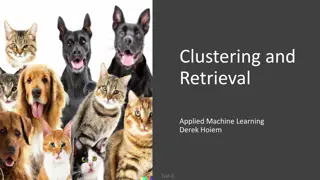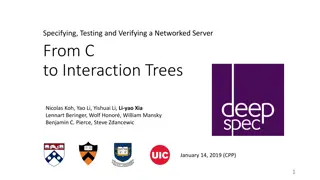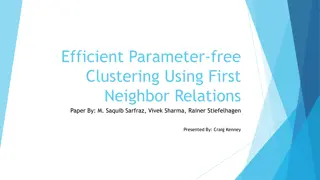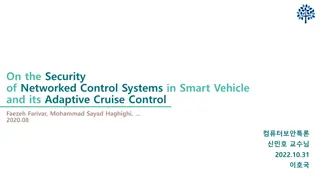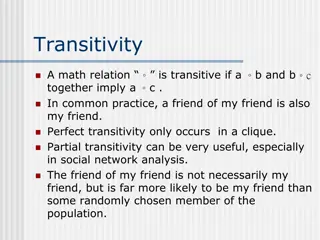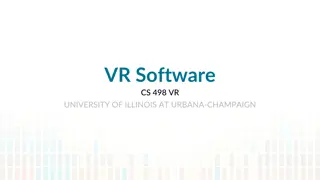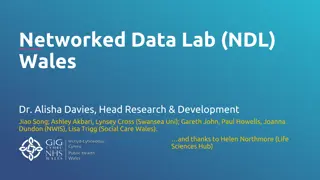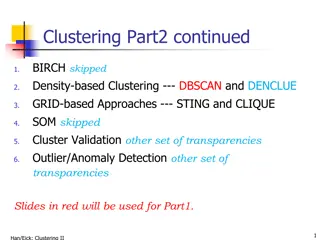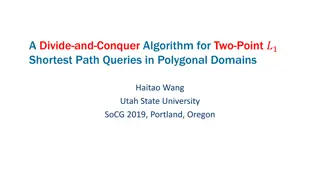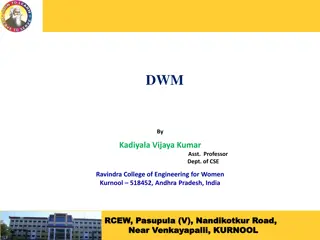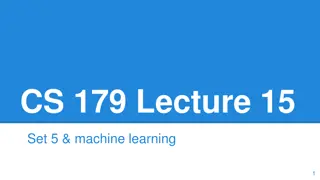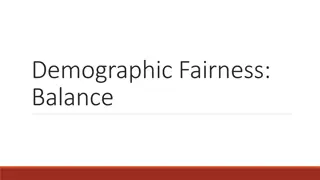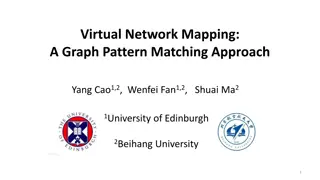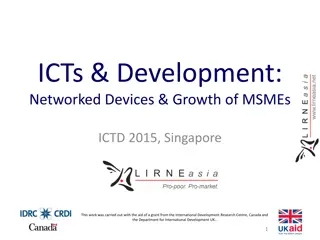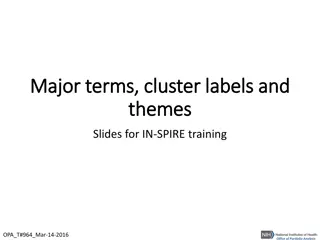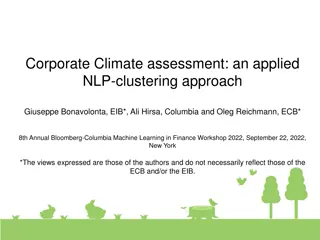Exploring Avatar Path Clustering in Networked Virtual Environments
Explore the concept of Avatar Path Clustering in Networked Virtual Environments where users with similar behaviors lead to comparable avatar paths. This study aims to group similar paths and identify representative paths, essential in analyzing user interactions in virtual worlds. Discover related works on path similarity clustering and density-based partitioning techniques applied in virtual environments.
Download Presentation

Please find below an Image/Link to download the presentation.
The content on the website is provided AS IS for your information and personal use only. It may not be sold, licensed, or shared on other websites without obtaining consent from the author. Download presentation by click this link. If you encounter any issues during the download, it is possible that the publisher has removed the file from their server.
E N D
Presentation Transcript
Avatar Path Clustering in Networked Virtual Environments Jehn-Ruey Jiang, Ching-Chuan Huang, and Chung-Hsien Tsai Adaptive Computing and Networking Lab Department of Computer Science and Information Engineering National Central University 2010/12/08
Outline Introduction Related Work Proposed Algorithms Experiments and Performance Conclusion 2
Introduction Networked virtual environments (NVEs) virtual worlds full of numerous virtual objects to simulate a variety of real world scenes allowing multiple geographically distributed users to assume avatars to concurrently interact with each other via network connections. E.G., MMOGs: World of Warcraft (WoW), Second Life (SL) 3
Avatar Path Clustering Because of similar personalities, interests, or habits, users may possess similar behavior patterns, which in turn lead to similar avatar paths within the virtual world. We would like to group similar avatar paths as a cluster and find a representative path (RP) for them. 4
Related Work Path Similarity Clustering Partitioning Hierarchical Density-based 5
Related Work Path Similarity Clustering Partitioning Hierarchical Density-based 6
For measuring pairwise similarity of vehicle motion paths in real traffic video of a cross road scene. It is suitable for paths of similar beginnings and stops. Path Similarity Average Distance of Corresponding Points (ADOCP) [Z.Fu et al. 2005] 7
Similarity(A, B)= LCSS(A, B)/min(|A|, |B|) Path Similarity(2) Longest Common Subsequence (LCSS) [M.Vlachos et al. 2002] for discovering similar multidimensional trajectories X position or y position A=((ax,1,ay,1), , (ax,n,ay,n)) B=((bx,1,by,1), , (bx,m,by,m)) 8 Time Adaptive Computing and Networking Laboratory Lab
Related Work Path Similarity Clustering Partitioning Hierarchical Density-based 9
Partitioning The method classifies the data into k clusters satisfying the following requirements: (1) each cluster must contain at least one object, and (2) each object must belong to exactly one cluster. E.G.: The k-means algorithm first randomly selects k data objects, each of which initially represents a cluster mean. Each remaining data object is then assigned to the cluster to which it is the most similar. Afterwards, the new mean for each cluster is re- computed and data objects are re-assigned. Cluster Number : K=3 10 Adaptive Computing and Networking Laboratory Lab 10
Hierarchical Hierarchical methods seek to build a hierarchy of clusters of data objects, and they are either agglomerative ("bottom-up") or divisive ("top-down"). 11 Adaptive Computing and Networking Laboratory Lab
Density-based Density-based methods typically regard clusters as dense regions of data objects in the data space that are separated by regions of low density. E.G.: DBSCAN processes data objects one by one and regards an object as a core object to be grown into a cluster if the number of the object s nearby objects within a specified radius r exceeds a threshold t. Adaptive Computing and Networking Laboratory Lab 12
Proposed Algorithms Pre-processing ADOCP-DC algorithm LCSS-DC algorithm 13
Pre-processing Dividing paths into path segments by hotspots Hotspot: an area that has attracted a large portion of avatars to stay long 14
Avatar Path Clustering Algorithms Average Distance of Corresponding Points-Density Clustering(ADOCP-DC ) Longest Common Subsequence-Density Clustering (LCSS-DC ) 15
ADOCP-DC Algorithm Corresponding point Let the length of a corresponding point v be Lv. The coordinate (or position) of v can be calculated by interpolation of the coordinates of the two consecutive sample points u and w that enclose v and are respectively of length Lu and Lw, where Lu Lv Lw. Let the coordinates of u and w be (xu, yu) and (xw, yw), respectively. The coordinate (xv , yv) of v can be calculated by Equations (1) and (2). Note that v=v0 (resp., v=vn) if v is the first (resp., last) corresponding point. 16
LCSS-DCpath transfers sequence SeqA:C60.C61.C62.C63.C55.C47.C39.C31.C32 18
LCSS-DCpath similarity SeqA :C60.C61.C62.C63.C55.C47.C39.C31.C32 SeqB :C60.C61.C62.C54.C62.C63.C64 LCSSAB:C60.C61.C62. C63 19
LCSS-DC similar path thresholds SeqA :C60.C61.C62.C63.C55.C47.C39.C31.C32 SeqB :C60.C61.C62.C54.C62.C63.C64 LCSSAB:C60.C61.C62. C63 20
Experiments Both methods are applied to the SL avatar trace data of Freebies Island. Each record includes avatar location data in the region within 24 hours. 22
Experiment Results 23 Avatar Path Clustering for SE Freebies
PerformanceAccuracy Silhouette [L. Kaufman et al. 1990] The value of Silhouette between from 1 to -1, the greater the Silhouette coefficient of the path, the higher path similarity in the cluster, and the lower path similarity with other cluster, which represents clustering result is better. 24
Performancecoverage the number of clustering paths the number of clustering paths Coverage= = the total of numbers of paths the total of numbers of paths 25
Accuracy Analysis in ADOCP-DC Algorithm Clustering radius Number of corresponding points Minimum number of clusters ADOCP-DC 16(AOI radius) >=10 >=150 26
Coverage Analysis in ADOCP-DC Algorithm Clustering radius ADOCP-DC 16(AOI radius) Number of corresponding points >=10 >=150 Minimum number of clusters 27
Accuracy Analysis in LCSS-DC Algorithm Cell diameter THa THb Minimum number of clusters LCSS-DC 32(AOI radius) 0.74 0.56 200 28
Coverage Analysis in LCSS-DC Algorithm Cell diameter THa THb Minimum number of clusters LCSS-DC 32(AOI radius) 0.68 0.65 300 29
Conclusion Two schemes for avatar path clustering: Average Distance of Corresponding Points-Density Clustering (ADOCP-DC) Longest Common Subsequence-Density Clustering (LCSS- DC) Applying the schemes to the SL trace data to evaluate the schemes silhouette degree and coverage ratio Future work: Avatar Behavior Analysis NVE Redesign Load Balancing Based on Path Clustering 30
Thank You! 31

